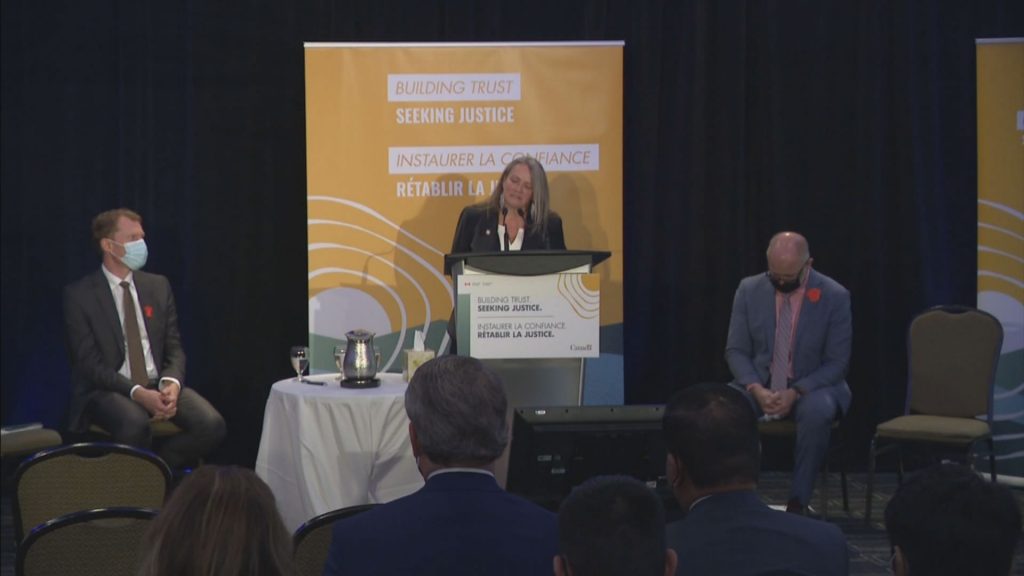
Murray is introduced as special interlocutor on unmarked graves during an Ottawa press conference on June 8. Photo: APTN
Kimberly Murray, a special appointee working on unmarked graves says a federal decision to contract an international organization to engage with Indigenous communities on the issue lacks transparency and risks causing harm.
Murray says she raised concerns directly with Crown-Indigenous Relations Minister Marc Miller on his department’s decision to spend $2 million to hire the International Commission on Missing Persons.
Based in The Hague, the organization specializes in identifying the remains of those killed or who have gone missing in major conflicts and disasters, including in Canada after the 2013 Lac-Megantic rail disaster.
Miller’s office says the organization will undertake a “cross-country outreach campaign” with Indigenous communities looking to hear options to help identify or repatriate the possible remains of children who were forced to attend residential schools.
Following their engagement services, which the minister’s office says will be done through the help of “local Indigenous facilitators,” the commission must provide its advice to the government in a report.
But Murray, who was appointed last year to serve as an independent special interlocutor on unmarked graves, says she is concerned with the lack of consultation done with Indigenous leadership before Ottawa inked the contract.
“There’s no transparency,” she said in a recent interview.
She says she is worried about the commission’s lack of experience working with residential school survivors and why the government is seeking another report on the matter when Murray’s office was already set up to provide it with advice.
“They’ve created Indigenous-led processes, but at the same time, it’s almost like they need a shadow report from a non-Indigenous entity for it to have any kind of credibility.”
“And they’re doing it sort of behind closed doors.”
A spokeswoman for Miller’s office said late Thursday that “agreements and documents will be shared when appropriate to do so, with input from all parties.”
Best practice approach needed
On Feb. 7, the Canadian Press reported that members of the Minegoziibe Anishinabe First Nation in Manitoba are at a “standstill” on how to proceed after the discovery of anomalies that could be unmarked graves or remains of their relatives, said Chief Derek Nepinak.
“We are at a point now where we have community members who are asking us to actually begin exhuming remains and we need help and we need assistance, and best practices might help us move in the right direction,” he said.
The community found 14 anomalies under a church on the site of the former Pine Creek Residential School last year after survivors spoke of “horror stories” in the basement.
The Pine Creek school ran from 1890 to 1969 in a few different buildings on a large plot of land. The National Centre for Truth and Reconciliation has a record of 21 child deaths at the school and survivors have long spoken about abuse there.
More anomalies were found through ground-penetrating radar around the former residential school site.
Nepinak said the First Nation reached out to RCMP to treat the area as a crime scene, but there hasn’t been much development on that front.
The community also spoke with Kimberly Murray, who is serving as an independent special interlocutor on the issue, and she provided some advice.
But, Nepinak said, the network of experts and communities analyzing possible unmarked graves in Canada is still in its infancy. There should be a collective best practice or policy approach for communities taking on this difficult and traumatic work, he added.
He said his community would welcome help from the international organization.
“We want to know how this is done. We want to know the experts. We want to know who we can call upon, who we can trust,” Nepinak said.









